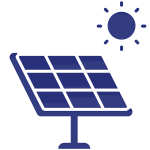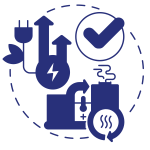Renewable energy for businesses
Request green energy quotes for your business today
Just enter your business postcode…
Request green energy quotes for your business today
Just enter your business postcode…
Start saving now
The British energy grid still relies on exhaustible sources of energy that are polluting the planet. Natural gas and nuclear materials are used to generate over half of the electricity on the National Grid.
However, both of these are finite resources with diminishing availability.
In contrast, renewable energy taps into inexhaustible green sources such as the sun, wind, and geothermal power.
Eco-conscious businesses increasingly turn to renewable energy sources to steer their operations towards a more sustainable future. This guide provides comprehensive insights into what you need to know about transitioning your business to renewable energy.
Businesses looking to embrace renewable energy have two primary options. Below is a summary, along with links to key information for each approach.
All of the best business energy suppliers now offer renewable energy tariffs where all the electricity they supply will be generated from renewable sources. Switching to a renewable business energy tariff is really simple and doesn’t require any upfront investment by your company.
With a renewable energy tariff, the fuel mix of your business’s electricity supply will comprise exclusively wind, solar, hydroelectric, and biomass sources.
UK planning laws make it easy for companies to install their own solar panels or wind turbines to directly generate their own renewable electricity. Additionally, any surplus electricity produced can be sold back to your supplier under the Smart Export Guarantee scheme.
We will begin our guide by discussing the main benefits of switching to renewable energy for your business.
Our business energy experts summarise the three key reasons for switching to a renewable business energy supply.

The main electricity supply in Britain still relies heavily on gas-fired power plants, which emit substantial volumes of greenhouse gases. This presents two major issues: firstly, natural gas, being a fossil fuel, is a finite resource; secondly, the emissions of greenhouse gases contribute significantly to global warming.
By adopting renewable energy, your business can eliminate the carbon footprint associated with its energy consumption. This not only bolsters your company’s environmental credentials but also contributes towards the UK’s net-zero goals.

Commercial electricity prices and business gas rates have soared over the last few years, largely due to a shortage of natural gas in Europe. Unlike traditional energy sources, the cost of renewable energy in the UK is less susceptible to geopolitical events such as wars or economic sanctions.
By opting for a fixed renewable business energy tariff or installing commercial solar panels, your business can mitigate the unpredictability associated with energy costs.

The UK government is actively encouraging businesses nationwide to adopt greener practices. Through business energy grants and other incentives, there is a strong guarantee of a robust return on investment for businesses opting to invest in renewable energy generation.
Furthermore, the Smart Export Guarantee scheme mandates business energy suppliers to purchase any surplus electricity generated by your business.
Here are the different types of renewable energy used to generate electricity on the UK grid. For a more detailed understanding, follow the links to our in-depth guides.
Solar energy is an inexhaustible energy source produced from the sun’s radiant light and heat. Using Photovoltaics (PV) or Concentrated solar power (CSP), the solar energy is converted into electricity.
In the past decade, the cost of solar panel technology has decreased significantly, making it possible for businesses to recover their initial investment within 3.5 to 4 years. Given that the average lifespan of a solar panel is around 30 years, investing in solar panels can be a very prudent long-term decision for businesses.
Commercial Solar Panels, assessing the suitability of solar panels for your business, commercial solar permits and regulations
Wind energy is generated by harnessing the kinetic energy of the wind through wind turbines located either on the coast or inland.
The process involves the wind turning the turbine blades, which face into the wind. These rotating blades are connected to a generator. This generator then converts the kinetic energy of the rotating blades into electrical energy.
Hydropower is a renewable energy source generated by harnessing the flow of water to produce sustainable energy. The simplest form of hydropower involves channelling flowing water to turn a water wheel, thereby generating power.
Large hydroelectric dams are capable of producing significant quantities of completely renewable energy, with the added benefit of not emitting greenhouse gases.
Hydropower, pumped hydro storage
Biomass energy involves converting organic matter derived from animals and plants into energy, yielding biofuels, heat, and electricity.
The most commonly used materials for producing biomass energy include corn and soy. The energy extracted from these sources is burned to generate heat and electricity. A notable example is the Drax Power Station, the UK’s largest single renewable energy source.
While there are numerous types of renewable energy, only a select few are practical for commercial properties. Constructing large-scale hydroelectric dams or geothermal power plants is generally not feasible for businesses. However, there are excellent options that are viable on a smaller scale.
Let’s explore the renewable energy generation options for businesses. For a comparative analysis, we will consider installations with a 5kW energy capacity. At the 2024 electricity rates, such a system could save a company approximately £1,200 in energy bills annually.

Renewable energy used: Photovoltaic panels convert solar energy from the sun into electricity.
Property requirements: Requires an area which receives direct sunlight and isn’t impacted by shade at any time of the day. Installation on a roof is typically the best option, but other solutions, like floating solar panels, also work.
Area requirements: A single panel is small but doesn’t generate much electricity on its own; usually, an array of panels is used for solar generation. A 5kW solar panel array will need 36 square meters of roof space.
Initial investment required: A typical 5kW solar panel array currently costs £7,000.
Planning requirements: Typically, no planning permission is required as these are considered permitted developments.
Permitted under the SEG: Yes

Renewable energy used: A wind turbine uses the energy in the wind to spin a turbine and generate electricity.
Property requirements: Requires a free-standing turbine erected in a suitably exposed position, think coastal areas or high atop hills where there is lots of wind.
Area requirements: An erected wind turbine must be far from other buildings and trees. You’ll need at least an acre of empty land.
Initial investment required: A typical 5kW pole-mounted turbine currently costs £25,000
Planning requirements: Turbines are permitted developments only in particular circumstances; the most stringent requirement is for the turbine to be less than 11.1 meters in height.
Permitted under the SEG: Yes

Renewable energy used: A hydroelectric system uses the kinetic energy of fast-moving water to generate hydropower. This can include small hydropower installations like run of the river.
Property requirements: You’ll need to have a watercourse running through your property with sufficient flow (the amount of water moving along) and head (how much height the water is losing within your property’s boundary).
Area requirements: A hydroelectric generation facility doesn’t take much room.
Initial investment required: A typical 5kW hydropelectricity installation currently costs £25,000
Planning requirements: All new hydroelectric systems require planning permission and an abstraction licence. You should contact your local authority early in considering a hydroelectric system.
Permitted under the SEG: Yes

Renewable energy used: A renewable micro-CHP system burns biofuel to generate heat and electricity. Note that many micro-CHPs still use fossil fuels such as natural gas; while these can be considered ‘low-carbon’ due to their efficiencies, they are not renewable.
Property requirements: None
Area requirements: There’s very little difference in size between a micro CHP installation and a traditional boiler.
Initial investment required: A typical 5kW commercial micro combined heat and power installation will cost around £20,000. Many different systems are available, so the exact pricing will depend on the circumstances.
Planning requirements: Not applicable as a micro-CHP system will typically be indoors.
Permitted under the SEG: Yes
Generating renewable energy locally at your business always requires an initial investment. The investment size depends on how much renewable energy capacity you want and your chosen generation type.
Commercial solar panels, currently the most cost-effective renewable energy technology, typically cost around £8,000 to generate an amount of electricity equivalent to the average household energy usage.
In the context of large business energy requirements, the potential investment in renewable energy can be substantially higher. Depending on the scale of your commercial renewable energy investment, here are some financing options:
Our business energy experts answer those frequently asked questions concerning renewable energy options.
The primary obstacle hindering most businesses from adopting renewable energy is the associated cost.
Natural gas has traditionally been the cheapest source for electricity generation, which explains its predominant use in the UK grid. Consequently, a renewable business energy tariff is usually more expensive than a standard equivalent.
Similarly, while grants and other incentives exist, the initial investment required for setting up commercial renewable energy can be substantial. This upfront cost may be prohibitive for many small businesses.
This is a query that’s asked a lot; however, green energy and renewable energy, despite their similarities, are not the same.
The Cambridge Dictionary defines green energy as “energy that can be produced in a way that protects the natural environment, for example, by using wind, water, or the sun”.
Whereas renewable energy is described as “energy that is produced using the sun, wind, etc., or from crops, rather than using fuels such as oil or coal”. Here’s a summary of the differences:
*There is disagreement in the scientific community about whether nuclear power constitutes a green, non-renewable energy source. Nuclear energy does not directly release greenhouse gases, but it does rely on mining nuclear material and produces nuclear waste.
It can be. A heat pump uses electricity instead of natural gas to heat a property. If the electricity used is generated by a renewable source, the heat pump can be classified as renewable.
A heat pump works by taking heat from external air, ground or water and transferring it into your property. Before transferring, the heat pump will apply pressure, and the pressure changes in gas will increase the temperature being transferred into the property.
By replacing a traditional gas boiler with a heat pump, most businesses will no longer have the need to pay a business gas supplier.